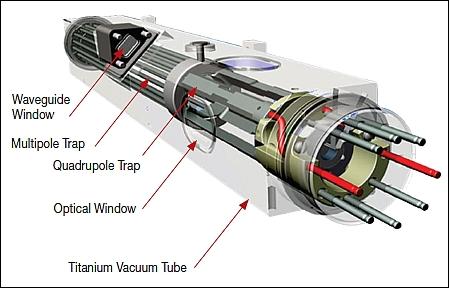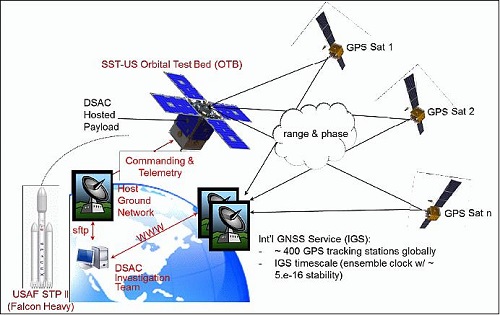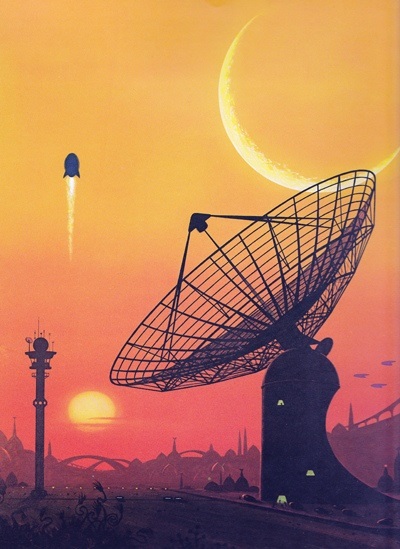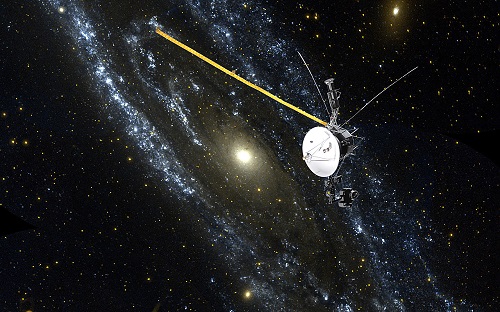Centauri Dreams
Imagining and Planning Interstellar Exploration
DSAC: Paradigm Changer for Deep Space Navigation?
We need to improve the way we handle data tracking and deep space navigation. While the near term is always uncertain because of budgetary issues, we can still take the long view and hope that we’re going to see a steadily increasing number of robotic and human spacecraft in the Solar System. That puts a strain on our existing facilities, and a premium on any methods we can find to make data return more precise and navigation more autonomous.
With these ideas in mind, keep your eye on the Deep Space Atomic Clock (DSAC). It’s a NASA technology demonstrator mission being built to validate a miniaturized, ultra-high precision mercury-ion atomic clock that researchers believe will be 100 times more stable than today’s best navigation clocks. Managed at the Jet Propulsion Laboratory, the DSAC has been tweaked and improved to the point where it allows drift of no more than a single nanosecond in ten days.

Image: Drawing of the DSAC mercury-ion trap showing the traps and the titanium vacuum tube that confine the ions. Credit: NASA/JPL.
We need improved atomic clocks in space to take spacecraft navigation to the next level and permit the next generation of studies of distant targets like Europa. Assuming Europa does have a subsurface ocean, this body of water will clearly be affected by tidal effects from Jupiter. Atomic clock measurements of DSAC’s caliber will be needed to provide the tracking data we’ll use to estimate Europa’s gravitational tide, helping to confirm the characteristics of its putative ocean. More on this thought and on the background of the DSAC in this JPL news release.
Europa, of course, is but one target whose investigation will be enhanced by projects like DSAC. Beyond this, improving the accuracy and stability of atomic clocks can change the way deep space navigation is done. Right now, we use a two-way paradigm for radiometric tracking, meaning that the same ground-based frequency standard is used as a reference for an uplink signal and a downlink detector. In other words, we track a spacecraft with our network on Earth and a ground-based team performs the necessary navigation. Improving the DSAC to allow it to operate in deep space will create a one-way tracking paradigm and autonomous navigation.
Think of the GPS unit you probably use to navigate with when you drive. GPS offers a one-way signal requiring no return signal from your car. The goal is to create the same one-way capability in deep space navigation. The smaller clock error (and DSAC is expected to be stable to less than 3 X 10-15 at one day, as measured by its Allan Deviation, a measure of frequency stability) enables one-way tracking with accuracies equal to or better than the two-way methods we currently use, a more flexible and efficient space navigation system.
The benefits of such a system will be striking, particularly in scenarios where we have several spacecraft either in orbit around or on the surface of a planet (Mars is the obvious reference for now). Let me pull a quote from Thornton and Border’s Radiometric Tracking Techniques for Deep-Space Navigation (Wiley, 2003):
…a single deep space antenna can acquire one-way Doppler and telemetry simultaneously from all spacecraft. Multiple uplink signals are not required. Consequently, this configuration results in more efficient use of ground-based resources and enhances orbit solutions and lander position estimates through the use of differential measurements.
Moreover, we get better signal-to-noise ratios for receiving spacecraft telemetry. Thornton and Border go on to explain the two reasons for this:
…one-way transmissions provide better short-term (< 1 s) stability, resulting in less signal loss in the detection process. This is because the short-term stability of two-way transmissions is degraded by solar plasma scintillations of the uplink signal and, for more distant spacecraft, by thermal noise in the spacecraft receiver. Second, the ground antennas are configured in a listen-only mode for one-way tracking, whereas the more complicated diplexer mode, required for simultaneous uplinking and downlinking, increases the effective system noise temperature of the ground receiver.
So DSAC technology can be a game-changer for deep space navigation, assuming the system checks out in flight. The plan is for the demonstration unit to be launched in 2016 aboard a SpaceX Falcon 9 Heavy booster, hosted on a spacecraft provided by Surrey Satellite Technologies. The equipment will be operated for at least one year, making use of GPS satellite signals to demonstrate precision orbital determination. Todd Ely (JPL), principal technologist for the DSAC Technology Demonstration Mission, describes the testing:
“Our in-orbit investigation has several phases beginning with commissioning, where we start up the clock and bring it to its normal operating state. After that we’ll spend the first few months confirming and updating our modeling assumptions, which we will use to validate the clock’s space-based performance. With these updates and our observation data, we’ll spend the next few months determining DSAC’s performance over many time scales…from seconds to days.”

Image: Overview of the mission architecture. Credit: NASA/JPL.
Following that period, the team will monitor clock telemetry to characterize its potential for long-term operations. The initial DSAC flight aims at producing the data that will help to make future units smaller and more efficient, readying them for the lengthy mission times that exploring deep space will demand. The kind of tracking data such a refined atomic clock will make available will improve spacecraft navigation and allow the precise tracking data we’ll need as we explore the moons of the gas giants and prepare for future targets even further out.

Exoplanet Spectrum in Visible Light
It’s the twentieth anniversary of the discovery of 51 Pegasi b, a ‘hot Jupiter’ that was the first planet to be discovered around a normal star. I always have to throw in that ‘normal’ qualifier because it was in 1992 that Aleksander Wolszczan and Dale Frail announced their discovery of planets around the pulsar PSR 1257+12, the first extrasolar planets ever found, and an extraordinary discovery in themselves. Michel Mayor and Didier Queloz announced the 51 Pegasi b discovery in 1995, and it was quickly confirmed by Geoff Marcy and Paul Butler.
51 Pegasi b, some 50 light years from Earth in the constellation Pegasus, is the prototypical ‘hot Jupiter,’ a gas giant orbiting in tight proximity to its star. A new paper from Jorge Martins (Universidade do Porto, Portugal) and team announces another first for this world, the first detection of the spectrum of visible light reflected off an exoplanet. The detection was made by painstakingly removing the host star’s spectrum to reveal the spectrum of the (by comparison) extremely faint planet.

Image: This artist’s view shows the hot Jupiter exoplanet 51 Pegasi b, sometimes referred to as Bellerophon, which orbits a star about 50 light-years from Earth in the northern constellation of Pegasus (the Winged Horse). This was the first exoplanet around a normal star to be found in 1995. Twenty years later this object was also the first exoplanet to be be directly detected spectroscopically in visible light. Credit: ESO/M. Kornmesser/Nick Risinger (skysurvey.org).
This is intriguing work because until now we’ve been largely confined to studying exoplanet atmospheres through a method called transmission spectroscopy, which allows scientists to study starlight filtered through the atmosphere during a transit. Also in common use is occultation photometry and spectroscopy, which measures the depth of the secondary eclipse as the planet passes behind the star (again, we’re talking about a transiting planet). Occultation spectroscopy is particularly useful in gauging the heat signature of the exoplanet.
The method deployed by Martins and team uses what is known as the cross-correlation function to extract meaning from the combined spectra of star and planet. Correlation is a mathematical operation that uses two signals to produce a third signal — this third signal is the cross-correlation of the two inputs. Using their spectroscopic data, Martins and team could amplify the signal of the planet and then remove the stellar signal to reveal the planet’s spectrum. The paper describes the basic principle at work:
…the cross-correlation function (hereafter CCF) can be used to mathematically enhance the S/N [signal-to-noise ratio] of our observations to a level where the extremely low S/N planetary signal can be recovered. The CCF of a spectrum with a binary mask (Baranne et al. 1996) has been extensively tested in detecting exoplanets with the radial velocities method. Briefly, this technique corresponds to mapping the degree of similarity between the stellar spectrum and a binary mask (representing the stellar type), which increases the S/N of the data by a factor proportional to the square root of the number of spectral lines identified in the mask.
The work was performed using the European Southern Observatory 3.6 meter telescope in conjunction with the HARPS spectrograph at La Silla (Chile). The results reveal that 51 Pegasi b is about half as massive as Jupiter although somewhat larger than Jupiter in diameter, with an orbital inclination of about nine degrees to the direction of the Earth. That means that the planet’s orbit is close to edge-on as seen from Earth, although not close enough to allow a transit. Remember, 51 Pagasi b was a radial velocity discovery, and the method used by Martins and his colleagues is not dependent on transits, unlike transmission and occultation spectroscopy.
Exposed to the intense starlight of its host star in such a tight orbit, the planet is highly reflective. And the fact that these properties can be deduced from the spectroscopic technique he has developed is promising for the future, as Martins explains:
“This type of detection technique is of great scientific importance, as it allows us to measure the planet’s real mass and orbital inclination, which is essential to more fully understand the system. It also allows us to estimate the planet’s reflectivity, or albedo, which can be used to infer the composition of both the planet’s surface and atmosphere.”
Moreover, the fact that existing equipment could produce these results points to the potential of future instruments on larger telescopes, such as the Very Large Telescope and the planned European Extremely Large Telescope. The ESPRESSO spectrograph (Echelle SPectrograph for Rocky Exoplanet and Stable Spectroscopic Observations) will greatly exceed the HARPS instrument to produce radial velocity measurements that can reveal Earth-like planets. Now being manufactured, the goal for first light of ESPRESSO on the VLT is 2016. The paper notes what the combination of advanced instruments and this new spectroscopic method means:
The sheer increase in precision and collecting power will allow for the detection of reflected light from smaller planets, planets on orbits with longer periods, or an increase in detail for larger planets like 51 Peg b.
The paper is Martins et al., “Evidence for a spectroscopic direct detection of reflected light from 51 Peg b,”

Habitable Worlds Around Tau Ceti?
Yesterday’s look at NExSS (the Nexus for Exoplanet System Science), NASA’s new ‘virtual institute,’ focused on the multidisciplinary nature of the effort. The work I’m looking at today, an analysis of the planets around Tau Ceti performed at Arizona State University, only emphasizes the same point. To get a read on whether two planets that are possibly in Tau Ceti’s habitable zone are likely to be terrestrial worlds like Earth, the ASU team brought the tools of Earth science into play, in particular the work of Sang-heon Shim.
Shim is a mineral physicist who worked with astrophysicists Michael Pagano, Patrick Young and Amanda Truitt in the Tau Ceti analysis. His perspective was vital because early work had already suggested that Tau Ceti has an unusual balance between the rock-forming minerals magnesium and silicon. In fact, the ratio of magnesium to silicon here is 1.78, about 70% more than we find in the Sun. That casts long-standing views of Tau Ceti as Sol’s twin into doubt, and raises questions about the nature of the planets that formed around it.

There is evidence for five of these, with two — Tau Ceti e and f — thought to be in the habitable zone. That’s an attractive possibility, for Tau Ceti is nearby at 12 light years, a solitary G-class star like the Sun, and a relatively stable one at that. No wonder it figures prominently in science fiction, its very proximity made a significant plot issue by Larry Niven in his 1968 novel A Gift from Earth, which depicts an isolated Tau Ceti colony that can still receive the occasional cargo from Earth. Isaac Asimov made a Tau Ceti planet the home of the first human extrasolar settlement in The Caves of Steel (1954).
Image: The Sun is at the left in this comparison with Tau Ceti. Credit: R.J. Hall via Wikimedia Commons.
In fact, I can think of few stars that have received so much attention from writers. Might some of the planets there really be habitable? The two planets we are looking at are ‘super-Earths,’ with masses of 4.29±2.00 and 6.67±3.50 times that of Earth respectively. The new work makes the prospect of Earth-like conditions unlikely. In fact, Shim’s mineralogical study indicates that the high magnesium/silicon ratio of the parent star could produce planets unlike any we’re familiar with, as the scientist explains:
“With such a high magnesium and silicon ratio it is possible that the mineralogical make-up of planets around Tau Ceti could be significantly different from that of Earth. Tau Ceti’s planets could very well be dominated by the mineral olivine at shallow parts of the mantle and have lower mantles dominated by ferropericlase.”
Ferropericlase is a magnesium/iron oxide that is thought to be a major constituent of the Earth’s lower mantle, along with silicate perovskite, which is a magnesium/iron silicate. Because ferropericlase is viscous, an abundance of it in the mantle would make mantle rock flow more readily, possibly affecting plate tectonics and volcanism at the planetary surface. The resulting world would pose challenges for the development of life, and certainly for its detection. “Faster geochemical cycling,” the paper notes, “could impede the buildup of biologically produced non-equilibrium chemical species in the planet’s atmosphere.”
The paper describes what it calls a detectability index, or DI, that gauges the ability of a planet to house life and to maintain biosignatures of the kind we hope to detect with new space telescope missions. Tau Ceti planets in the habitable zone might, in other words, be habitable, but unlikely to produce detectable life signs in their atmospheres. Life would not necessarily be absent, but detecting it would require a thorough study of planetary evolution.
Another issue is the length of time a planet spends in the habitable zone. Tau Ceti e’s position is deeply problematic. The authors believe the world is reaching the end of its habitable lifetime and is at best on the extreme inner edge of the habitable zone. Tau Ceti f, meanwhile, appears to be near the outer edge of the habitable zone, but evidently moved into it within the past 1.5 billion years, and probably in much less time than this.
Assume even a billion years in the habitable zone and bear in mind that Earth’s biosphere took roughly two billion year to produce biosignatures that would be theoretically detectable. The DI for this world — our ability to find life if it does exist on Tau Ceti f — would be low indeed. A long habitable lifetime may be in this planet’s future, but that doesn’t help us now:
Even in the most pessimistic case, the planet will have about 7 Gy of habitable lifetime until the end of the main sequence, plus additional time while the star traverses the subgiant branch. From a detectability standpoint, however, f is a poor candidate. At best, the planet has been in the HZ for < <1Gy under these assumptions.
So we have in Tau Ceti f a world where life could exist but would be, at least according to what we know of life here on Earth, probably in an early state and unlikely to be detectable. There is a significant lesson for us in this conclusion, as the paper goes on to note:
The rate of change of L [luminosity] and Teff [stellar effective temperature] as a function of time means that cases similar to f where a planet enters the HZ in the latter part of the star’s life are more common than planets that have been in the HZ since early times. This serves as a reminder that the present “habitability” of a planet does not necessarily indicate that it is a good candidate for detecting biosignatures. The temporal evolution of the system must be taken into account.
So much, then, for the notion that if we detect a planet in the habitable zone, we are safe in assuming life has had time enough to emerge there. Here we have one case of basic mineralogy casting doubt over whether surface conditions are habitable or whether it could be detected by our instruments if present, and another where the movement of a planet into the habitable zone means that biology may flourish there but only in our distant future.
The paper is Pagano et al., “The Chemical Composition of τ Ceti and Possible Effects on Terrestrial Planets,” Astrophysical Journal Vol. 803, No. 2 (2015), Art. 90 (abstract / preprint).

NExSS: A ‘Virtual Institute’ for Deep Space
The Nexus for Exoplanet System Science, or NExSS, is a collaborative initiative from NASA to draw on the collective talent of researchers from ten universities, three NASA centers and two research institutes. Conceived as a ‘virtual institute,’ the effort is both geographically diverse and multidisciplinary in nature, focusing not only on the search for exoplanets but the attempt to analyze planetary environments and find life. Jim Green, NASA’s Director of Planetary Science, explains the concept:
“This interdisciplinary endeavor connects top research teams and provides a synthesized approach in the search for planets with the greatest potential for signs of life. The hunt for exoplanets is not only a priority for astronomers, it’s of keen interest to planetary and climate scientists as well.”
NExSS draws on the collective expertise of its participants in the areas of Earth science, planetary science within our Solar System, heliophysics and astrophysics to create what NASA is calling a ‘system science’ approach aimed at advancing the search for life on exoplanets. The effort will be led by Natalie Batalha of NASA’s Ames Research Center, Dawn Gelino with NExScI, the NASA Exoplanet Science Institute, and Anthony del Genio of NASA’s Goddard Institute for Space Studies. This NASA news release gives a brief summary of the different teams, selected from proposals submitted to the agency, and the subject of their work.

Image: The search for life beyond our solar system requires cooperation across scientific disciplines — the way the UW-based Virtual Planetary Laboratory has been working since 2001. Now, NASA’s NExSS collaboration will take a similarly interdisciplinary approach to the search for life. Participants include those who study Earth as a life-bearing planet (lower right), those researching the diversity of solar system planets (left), and those on the new frontier, discovering worlds orbiting other stars in the galaxy (upper right). Credit: NASA.
Sixteen projects in all have been funded through NExSS, and while I won’t try to go through all of them today, I do want to look at two a little more closely. At UC Berkeley, James Graham is leading a project that will include researchers at Stanford University. The collaboration, says Graham, draws together three different approaches to exoplanet hunting:
- Direct imaging: The Gemini Planet Imager, for which Graham is project scientist, began its exoplanet survey at the Gemini South Telescope in November of last year, taking direct images of planets in the infrared.
- Doppler methods: UC-Berkeley’s Geoff Marcy perfected the so-called ‘wobble’ technique that measures the effect of planets on the host star to deduce information about these worlds.
- The transit method: Planets passing in front of their star as viewed from Earth have been detected in abundance by the Kepler mission, which has found almost 2000 of them.
The goal of the Berkeley project is to study the three methods and their overlap, using not only the Gemini South instrument but also the Keck Observatories in Hawaii and, when it becomes available, the Thirty Meter Telescope planned for a site next to Keck on Mauna Kea. “It is a wonderful confluence of multiple approaches to planet-hunting that allows us to detect planets that are both near and far from the host star,” adds Marcy, a reference to the Gemini Planet Imager’s ability to find worlds in much more distant orbits than transit or Doppler methods. UC-Berkeley’s news release is here.
At the SETI Institute, researcher Hiroshi Imanaka, a specialist in the chemistry of planetary atmospheres, is part of another team selected by NExSS out of the pool of proposals. Imanaka’s focus is on habitable zones, as he explains in this SETI Institute news release:
“One major thrust of the exoplanet community has been to find worlds orbiting in the so-called habitable zone. That’s the range of distances from a star where a planet could have temperatures permitting liquid oceans. However, liquid oceans are not the only condition under which life can exist. Some of the moons of Jupiter and Saturn are examples of places that are not in the conventional habitable zone, but might be nonetheless habitable. We want to take further steps to characterize habitable environments that lie beyond the solar system.”
In keeping with the wide-range encouraged by NExSS, Imanaka’s work draws on planetary science and astrobiology to study Titan in light of the clues it can provide about planets detected by teams like those at UC-Berkeley. His team is made up of Titan specialists who study the moon’s thick, smoggy atmosphere and exotic ethane seas. Whether or not Titan has life today, Imanaka considers it a ‘pre-biotic’ world that is producing the most complex organic compounds we know of outside Earth. The team hopes to tap the expertise of the NExSS network as it considers how conditions on Titan can inform our study of smoggy exoplanet atmospheres.
I’ll turn you back to the NASA news release for a breakdown of the other projects, which include Debra Fischer’s team at Yale working on spectrometers of Earth-detecting precision for nearby stars, Drake Deming’s team at Yale using Kepler data to study exoplanet atmospheres, and Jason Wright’s Penn State team studying ‘hot Jupiter’ atmospheres with a high-precision technique called ‘diffuser assisted photometry.’ The news release offers links to each.
The formation of NExSS comes at a time when we’re still making discoveries from the abundant Kepler data and anticipating future missions like TESS (Transiting Exoplanet Survey Satellite), which will, unlike Kepler, home in on exoplanet possibilities around nearby stars, and the James Webb Space Telescope, which will measure the infrared spectrum of starlight passing through the atmospheres of transiting exoplanets. Both missions are to be launched within the next few years. The Wide-field Infrared Survey Telescope (WFIRST), scheduled for launch in about ten years, will offer wide-field imaging and spectroscopic surveys of the near infrared sky. NExSS exemplifies the multidisciplinary approach necessary to pull all this incoming information together.

Project Dragonfly: Design Competitions and Crowdfunding
by Andreas Hein
Centauri Dreams readers most likely know Andreas Hein as the head of Project Hyperion, an effort for Icarus Interstellar to examine the prospects for manned interstellar flight, but he has also written in these pages about the uploading of consciousness. Now working on his PhD at the Technical University of Munich, Andreas today tells us about a new Kickstarter campaign in support of Project Dragonfly. Developing under the auspices of the Initiative for Interstellar Studies (of which Andreas is deputy director), Dragonfly explores interstellar flight at the small scale, and as he explains below, leverages the advances in computing and miniaturization that designers can use to change the paradigm of deep space missions.

Humanity has existed for over 200,000 years. It is only about 200 years since we entered the age of industrialization, and in the last 50 years, we have discovered ways of going to the stars [1]. However, the approaches conceived required spaceships the size of a tanker and massive space infrastructures. Today we live in a time when we may soon have the technological capabilities to launch a spacecraft to the stars, but now the spacecraft may be no bigger than a suitcase. Project Dragonfly is the first design study for an interstellar mission based on a small, laser-propelled spacecraft. In this article, I will explain the background of Project Dragonfly and the rationale for the Project Dragonfly Design Competition and crowdfunding campaign.
Many previous approaches for going to the stars have depended on extremely large and heavy spacecraft, based on propulsion systems like nuclear fusion or antimatter. Existing concepts of fusion-propelled spacecraft are as heavy as skyscrapers. Accelerating all the fuel with the ship until it is exhausted is actually not a very efficient way to get to the stars. Project Dragonfly aims at a different approach: The basic idea is not new – it is, in fact, very old. For centuries, humans have travelled the seas using sailing ships. We also plan to use a sail. But a sail which is made of an extremely thin reflective surface. This sail would be illuminated by a laser beam from a laser power station somewhere in the Solar System [2]. The photons of the laser beam push the sail, just as the wind pushes the sail of a sailing ship. And through this push to the sail, the spacecraft slowly accelerates.
However, as the spacecraft does not use any on-board fuel, it can accelerate to very high velocities in the range of several percent of the speed of light. Furthermore, Project Dragonfly builds upon the recent trend of miniaturization of space systems. Just a few decades ago, thousands of people were involved in developing the first satellite, Sputnik. Today, a handful of university students are able to build a satellite with the same capability as Sputnik, one that is much cheaper and weighs hundreds of times less than the first satellite. Recently, NASA announced a prize for the development of interplanetary CubeSats [3].
We simply think further. What could we do with these technologies in 20 or 30 years? Would it be possible to build spacecraft that can go to the stars but are as small as today’s picosatellites or even smaller? It is time to explore and innovate.

Image: Swarm of laser-sail spacecraft leaving the solar system. Credit: Adrian Mann.
History of the Project
The idea behind Project Dragonfly emerged in early 2013 when I visited Professor Gregory Matloff in New York. Matloff, author of The Starflight Handbook, is one of the key figures in interstellar research with major contributions to the area of solar sails. We talked about different propulsion methods for going to the stars and realized that nobody had yet done a mission design for an interstellar laser-propelled mission. Soon after this conversation, Project Dragonfly was officially announced by the Initiative for Interstellar Studies (i4is), with Kelvin F. Long and myself as co-founders.
However, it took another year to get to the point where we were able to organize an international design competition in order to speed up our search for a feasible mission to another star, based on technologies of the near future. One of the challenges for defining proper requirements for the competition was the development of preliminary mission concepts in order to identify performance drivers and showstoppers. Once these preparations were finished, we could launch the competition. See my essay Project Dragonfly: The case for small, laser-propelled, distributed probes for an early competition announcement and scientific backgrounder.
Why a Competition?
Design competitions have a long tradition in the history of technology: The Longitude rewards for the precise determination of a ship’s longitude at sea (1714), the Daily Mail prize for crossing the English Channel by an airplane (1908), the Orteig prize for crossing the Atlantic with an airplane (1919), and more recently DARPA’s Grand Challenge, which focuses on developing autonomous vehicles (2004). These competitions defined a set of requirements — most importantly performance requirements — the technology would need to fulfill. The solutions were up to the entrants.
Competitions offer the advantage that almost anyone can participate. This opens up opportunities for new entrants and innovative solutions, with the potential to disrupt the existing technological landscape [4]. Of course, with Project Dragonfly we are not yet at the level of the “Grand Challenges”. Nevertheless, the so-called Alpha Centauri Awards were announced by Kelvin Long in 2013, offering several cash prizes for relevant areas in interstellar travel. The Project Dragonfly Design Competition is one of the areas for which the Alpha Centauri Prize will be awarded [5].
The objective of the Project Dragonfly Design Competition is to develop a feasible mission design for a small, laser-propelled interstellar mission. Four international university teams are currently working on studies for small, laser-propelled interstellar spacecraft: Cairo University, the Technical University of Munich, the University of California Santa Barbara (UCSB), and Cranfield University, working with the Skolkovo Institute of Science and Technology (Skoltech) in Moscow and the University Paul Sabatier (UPS) in Paris. The final design reports of the teams will cover all areas that are relevant to make the mission a success and to return scientific data: Instruments, communication, laser sail design, power supply, secondary structure, deceleration propulsion, etc. Furthermore, both technological as well as economic feasibility will be assessed by the teams.

Image: The Project Dragonfly design team at Cairo University, made up of aerospace and communication engineering students, is one of four working on laser sail design.
The teams will meet with members of i4is in London at the headquarters of the British Interplanetary Society this July in order to evaluate their designs. The results from the competition will serve as a basis for future technology development of such a mission.
Project Dragonfly Kickstarter Campaign
The Initiative for Interstellar Studies has now launched the first ever Kickstarter campaign for supporting an interstellar design competition. The funds raised during the campaign will allow us to support the student teams during the competition. The campaign began on the 15th of April and will run until May 14th. All supporters will receive unique and exclusive rewards for their pledges, among them T-shirts and posters with an image of the winning team’s spacecraft, painted by the grand master of space art, David A. Hardy. The campaign is further supported by renowned space artist Adrian Mann. Further awards consist of a 3D-printed version of the winning team’s starship as well as early access to team reports, a signed version of the Beyond the Boundary book edited by Kelvin F. Long, etc.
The campaign can be accessed via:
https://www.kickstarter.com/projects/1465787600/project-dragonfly-sail-to-the-stars
Thanks a lot in advance for your support. Let’s find a way to get to the stars in our lifetime!

Image: An evocative futurescape by space artist David A. Hardy.
References
[1] Dyson, F. J. (1968). “Interstellar transport.” Physics Today, 21(10), 41-45.
[2] Forward, R. L. (1984). “Roundtrip interstellar travel using laser-pushed lightsails.” Journal of Spacecraft and Rockets, 21(2), 187-195.
[3] Staehle, R., Blaney, D., Hemmati, H., Lo, M., Mouroulis, P., Pingree, P., … & Svitek, T. (2011, August). “Interplanetary CubeSats: opening the solar system to a broad community at lower cost.” In CubeSat Workshop, Logan, UT, USA (pp. 6-7).
[4] Calandrelli, E. D. (2013). An evaluation of short innovation contest implementation in the federal context (Masters’ Thesis, Massachusetts Institute of Technology).
[5] Hein, A.M., Project Dragonfly Design Competition website
http://www.i4is.org/news/dragonfly

Voyager to a Star?

The latest imagery from New Horizons has me wondering what it must be like to be on the team for this mission. Although released a week ago, the photo at left was taken by the Ralph color imager aboard the spacecraft on April 9. The distance from Pluto and Charon in the shot is about 115 million kilometers. This is the first color image ever made of Pluto/Charon by an approaching spacecraft, one that gives us a sense of what lies ahead as the distance continues to diminish. Imagine being part of this long effort and seeing a new world and its system of moons swimming into focus, unveiling landscapes never before seen.
New Horizons takes me back to the Voyager days, and in the context of the approach to Pluto/Charon, the publication of Jim Bell’s The Interstellar Age (Dutton, 2015) is truly apropos (I’m sure the publishers had exactly this in mind). Subtitled “Inside the Forty-Year Voyager Mission,” the book lets us glimpse what it was like inside JPL when the planetary encounters occurred. Bell, now president of the Planetary Society’s board of directors, was caught up in Voyager as a young grad student at Caltech, a formative experience in his career as a planetary scientist. In describing new planets coming for the first time into detailed view, he turns to the words of an old friend:
“The sense of exploration we get with these missions is a very ‘human explorer’ kind of feeling, even though our senses are on the distant spacecraft,” my friend, planetary science colleague, and Voyager imaging team member Heidi Hammel says. “I feel like an old-fashioned mountain climber when I am making discoveries, seeing something for the first time, realizing that no human before me has ever seen what I am seeing. It takes your breath away— for just a moment you feel a pause in time as you know you are crossing a boundary into a new realm of knowledge. And then you plunge in, and you are filled with childlike joy and wonder and delight.”
Hammel goes on to say that you have to temporarily shelve that feeling if you’re a scientist working on the mission, at least while an active encounter is going on. But the wonder of the event is something you always have with you, and it’s something a good scientist wants to share. It’s interesting in the New Horizons context that Bell talks about Jon Lomberg’s One Earth: New Horizons Message project. What Lomberg has in mind for New Horizons, you’ll recall, is an uploaded message, a Voyager ‘Golden Record’ sent digitally into the spacecraft’s computer memory after its Solar System work is done (see New Horizons Message Update].
Could we do something like this for the Voyagers? It’s an intriguing notion. Lomberg pointed out to Bell that while the Golden Record will always be a part of Voyager, there is nothing on the spacecraft that tells of its remarkable passage through our Solar System, something that says ‘here’s what Voyager was and here’s what Voyager found.’ Bell would like to see us upload some of these historic photos. Imagine: The volcanoes of Io, the spectacular cliffs of Miranda, the bizarre cantaloupe terrain of Triton, all could be used to create what he calls an ‘electronic postcard’ that will complete the Voyager story for any future intelligence that finds them.
And is a trajectory change a possibility? This is interesting stuff. Right now, the Voyagers will take about 30,000 years to reach the outer edge of the Oort Cloud (the inner edge, according to current estimates, is maybe 300 years away). Add another 10,000 years and Voyager 1 passes some 100,000 AU past the red dwarf Gliese 445, which happens to be moving toward the Sun and will, by this remote date, be one of the closest stars to the Solar System.
As to Voyager 2, it will pass 111,000 AU from Ross 248 in roughly the same time-frame, at which point the red dwarf will actually be the closest star to the Sun. According to Bell, Carl Sagan and the team working on the Golden Record wondered whether something could be done about the fact that neither Voyager was headed for the interior of another Solar System. Is it possible that toward the end of the Voyagers’ active lifetimes (somewhere in the 2020s), we could set up a trajectory change that would eventually lead Voyager to a star?
The idea comes out of Sagan’s Murmurs of Earth (Random House, 1978), which Bell quotes as he describes the concept:
Both [Sagan and the Golden Record team] and I wonder if it might be possible to command one final “empty-the-tank” thruster firing, just before final communication with each Voyager is lost, to “redirect the spacecraft as closely as possible so that they will make a true encounter [with these stars]. If such a maneuver can be affected then some 60,000 years from now one or two tiny hurtling messengers from the strange distant planet Earth may penetrate into their planetary systems.” If no one else does, I will try to remember to make this request to Suzy Dodd or whoever is running the Voyager Project in a decade or so, as the spacecraft power levels wind down. We have the fuel. Feel free to mention it to your congressperson.

A trajectory change would increase only infinitesimally the faint chance that one of these spacecraft would someday be intercepted by another intelligent civilization, but the message of this maneuver is really to us. There is a certain magic in the idea that these venerable machines might one day be warmed by the light of another sun. In any event, I’m much in favor of Pioneer plaques, Golden Records, and One Earth Messages, as they remind us that our spacecraft are our emissaries as well as our scientific tools. How we conceive of them through the information they carry helps us gain perspective on ourselves, and shapes the context of all our future explorations. If we can do it, I’m all for giving the Voyagers one last, hard nudge into the unknown.


